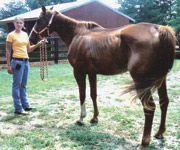Refeeding starved horses
Recovery from malnutrition, starvation takes time, patience.
A combination of last year's higher gas prices, drought and resulting poor hay crop, plus this year's economic downturn and the effects of anti-slaughter legislation have caused a spike in the number of starved and rescued horses being seen by veterinarians.

Before and after: These photos show a malnourished horse (above) with a rescue worker at a state impound facility and the same horse (below) restored to health after a proper re-feeding program. It is important that veterinarians and care-givers responsible for rehabilitating starved horses resist the urge to give them a diet rich in grain. Alfalfa hay fed in small amounts over a number of days and a slow approach to weight gain will result in a much more desirable outcome.
"Generally we would see a few cases monthly, but now we are getting that number of actual cases and consultation calls weekly," says Dr. Carolyn Stull, animal welfare extension specialist at the University of California-Davis School of Veterinary Medicine,
The most common reasons for severely malnourished horses, Stull adds, is "owner ignorance followed by economic hardship."
Reinforcing her observation, a report from the University of Minnesota College of Veterinary Medicine says, "Most cases of starvation or severe malnutrition originate from owners who acquire more horses than they have interest in caring for or the means to care for."

Veterinarians often are called in to help private individuals or state and local animal rescue organizations with the rehabilitation of chronically starved horses. Such cases usually are far more involved than they appear initially.
"Re-feeding starved animals, including humans, is not an easy process," Stull says. Many nutritional and biochemical processes are altered when horses go without adequate food for long periods. Re-feeding these individuals without a proper knowledge of the problems they are likely to encounter and without an appropriate feeding program and schedule likely will result in the death of a significant number of horses, Stull warns.
Assessing the overall horse
The first step in dealing with a starved horse and planning its rehabilitation is to obtain an overall assessment. The horse's general appearance and its body score [1 (emaciated) to 9 (obese), based on the Body Condition Assessment or Scoring System (Henneke et.al., 1983)] should be noted.
It is important that the horse be handled and that body score be based on actual palpation rather than on visual examination. Long hair coats in the winter or early spring (the peak seasons for starvation cases) can make it difficult to judge body condition accurately.
Scores of 4 to 6 are considered optimal for healthy horses, while scores below 3.5 are typical for emaciation/starvation cases. These horses have a prominent backbone and only a slight flesh covering over the ribs. The tail head is evident on these horses, and neck, withers and shoulders are emphasized. The head of a starved horse appears disproportionately large, and it may have poor to little hair coat, a depressed attitude with low-hanging head, motionless tail and ears, dull eyes, lethargy, nervousness and a lack of interaction with herdmates.
Because so many factors may contribute to starvation or affect its reversal, a complete step-by-step approach to these animals is needed.
A good physical examination should be done to investigate any possible arthritic reasons (cannot get to food or maintain herd position adequately to get enough nutrition), dental reasons (poor dentition so that it cannot process food), metabolic reasons (Cushing's disease, parasitic overload), cardiac, respiratory, immunologic or other reasons for starvation.
If any underlying problems are found, they should be addressed while the re-feeding process is being started because horses may not respond well to rehabilitation if potentially serious diseases or conditions are not treated.
What happens during starvation?
A normal horse uses stored fats and carbohydrates for energy, exercise and all normal body functions. These fats and carbohydrates are constantly replenished through adequate dietary intake. Starvation interrupts the replenishment of body stores so the horse initially uses all stored and available fats and carbohydrates. If starvation is halted at this point, a thin horse will generally recover fully, once given access to feed.
Horses that are chronically starved, however, will begin to use protein when fats and carbohydrates are used up. A starving body cannot select which tissue protein will be metabolized for energy; "consequently, the starved body uses protein, not only from skeletal muscle, but also from vital tissues such as the heart and gastrointestinal tissues," Stull explains.
As time passes, the horse's condition becomes more precarious. "When it loses more than 50 percent of its body weight, the prognosis for survival is extremely poor," according to Stull.
Re-feeding starved animals requires that caretakers refrain from killing them with kindness.
The natural first reaction is to want to give it access to good, rich food and to allow it to "eat itself back to health." But nothing could be worse. Feeding concentrated calories to a starving horse likely will result in "Re-feeding Syndrome" and death in three to five days.
Such high-caloric feeding causes a rise in insulin, Stull and other nutritionists explain. The insulin peak encourages the storage of carbohydrates into cells for future use, but also causes magnesium, calcium, potassium and phosphorous to be drawn into cells. The intracellular distribution of these electrolytes can have serious consequences because in starved individuals electrolytes have been depleted, so that they barely have enough for normal function.
When potassium, magnesium and phosphorus become depleted in the general circulation, a cascade of events can occur, leading to kidney failure, respiratory failure, cardiac collapse and death.
The problems starved horses face are similar to those of performance horses suffering from "exhausted horse syndrome" due to a loss of electrolytes incurred during maximal exercise, usually in hot weather.
Hypokalemia can result in weak muscles and neurologic dysfunction. Poor heart-muscle function, seizures and coma also can occur. Hypomagnesaemia can produce nervous, irritable or aggressive horses, and hypophosphatemia can result in hemolytic anemia.
Simple diet recommended
Because of the importance of reducing insulin elevation while re-feeding and because of the extreme sensitivity of starved horses to concentrations of potassium, magnesium and phosphorus, the best diet to use is surprisingly one of the simplest.
"The best approach to re-feeding a starved horse is to give frequent (every 4 hours) meals of high-quality alfalfa hay," Stull says.
One pound or about one-sixth of a flake at each meal will provide a good source of protein to begin rebuilding the body. Because alfalfa is high in calcium, magnesium and phosphorus, it helps provide electrolytes that reduce the risk for catastrophic system failure.
This diet should be maintained for 10 days, though the amount of alfalfa can be increased (up to four pounds) and the number of feedings decreased (to three) for Days 4 through 10.
After 10 days the horse can be fed as much alfalfa as it will eat in two feedings, and it should be allowed access to a salt or electrolyte mix. Feeding grain or other supplements should be avoided until the horse is well on its way to recovery, which can take 60 to 90 days.
Full return to normal body weight may require three to five months. Caretakers are urged to be patient and to go slowly because overly aggressive feeding and the introduction of calories too early will worsen the prognosis for recovery.
Poor prognosis
Even with the best of situations and attention to proper diet, the odds often are not in favor of severely starved horses. Researchers in the Veterinary Services and Animal Industry branches of the Manitoba Agriculture, Food and Rural Initiatives report that "about 20 percent of severely malnourished horses can be expected to die in spite of attempts at re-feeding."
In an article titled, "Chronically starved horses: predicting survival, economic and ethical considerations," these researchers looked at the case of 45 chronically starved horses that were impounded under the Manitoba Animal Care Act, evaluated and rehabilitated and then sold at auction.
Detailed records of the cost of this action included transport, carcass disposal and use of a dedicated rehabilitation paddock, feeding, medication and antiparasite medication.
Costs were not even closely covered by the eventual sale of the surviving horses, the researchers say. While sensitive to the differing value placed on horses as opposed to other large-animal species, the researchers debate the ethics of managing severely starved and at-risk horses. They question whether early euthanasia may be a more reasonable option for some starved horses, given the difficulty in rehabilitation, time required and the cost to rescue organizations.
"Future policy direction," they write, may require a balance between fiscally responsible management of welfare cases and what is considered acceptable to the public at large."
Prevention of starvation cases is the best solution, and education is the key to prevention.
Veterinarians are encouraged to accept their role in owner education, providing nutritional and management consultation when possible. When faced with re-feeding a starved horse, veterinarians are reminded to take a long-term approach and be aware of the specific requirements and needs of these unique animals.
Marcella is an equine practitioner in Canton, Ga.